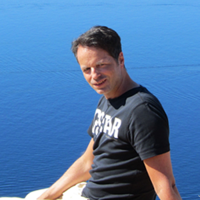Prof. Dr. rer. nat. Claus Feuchter
Following his studies in physics at the Technical University of Munich, Professor Feuchter received his doctoral degree from the Department of Mathematics and Theoretical Physics at the University of Tübingen in 2006 for research in the field of non-Abelian quantum field theories. He subsequently worked as a researcher in various positions in industry. Since 2011 he has been Professor in Fluid Dynamics at Aalen University.
His group conducts research on kinetic theory of gases with a special focus on the development of Lattice Boltzmann methods for the simulation of turbulent flows, aeroacoustics, and microfluidics.
Research Topics
For many real-world applications, scale resolving simulations such as direct numerical simulation (DNS) or large eddy simulation (LES) are required to reliably predict anisotropic turbulence effects, transitional flows or acoustic emissions. The range of scales involved in such flows is so wide that their direct numerical resolution became rapidly intractable even for the most powerful computer architectures. Due to its low numerical dissipation and computational efficiency, modern Lattice Boltzmann (LB) methods are excellent candidates for the simulation of turbulent flows (DNS/LES).
The core activity of our research is to develop mathematical models for scaled-resolved turbulent simulations (LES/DNS) based on the LB method. Furthermore, the application of these algorithms to real-world applications is of crucial importance.
Flow-generated noise has gained an increasing amount of attention due to its relevance for many engineering applications. The sound generation by turbulence is a very complex phenomenon including a large number of physical scales and requiring an unsteady and highly accurate numerical modelling of the ow and acoustic fields. The length scales of the acoustic sources are usually very different from the acoustic wavelength. The main problem is that acoustic quantities are several orders smaller than the aerodynamic counterparts, which makes it difficult to resolve them accurately and requires CAA schemes with very low numerical noise. Concerning aeroacoustics, it has been shown that LB methods are able to capture the weak acoustic fluctuations due to its low dispersion and low dissipation properties.
Our research focus is on the mathematical development of CAA methods for turbulent flows and the application to complex industrial applications.



